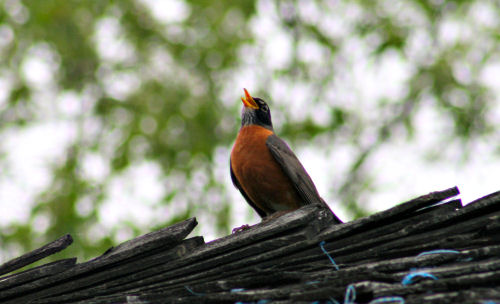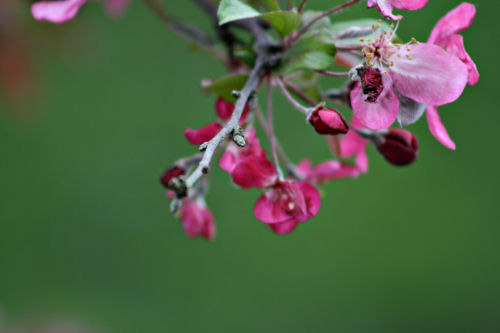A 365-Day Project
"We Are All Mozart"
A project to create
new works and change
the perception of the
music of our time.


 May 29, 2008
May 29, 2008 
The next few days will be a ramble. It all began five weeks ago, on April 22, when NewMusicBox editor Frank J. Oteri wrote about the mass of musical scores he had inherited from the family of composer Gabriel Von Wayditch. It was effectively the continuation of a discussion addressed separately by Barton McLean and me several years ago about the future of music in a past-hostile culture.
If you read the whole NewMusicBox article and all the discussion, you will learn how tangled the issue of archiving can be. I will summarize a little later; for now, here is what I have been doing the past few days while not writing these commentaries.
David Gunn has been updating his website with scores and musical examples, and had been sending me notes over the past few months about recordings he needed: A Conversation Piece from one of two possible recordings from 1975; And Dymns the Welkin, either from 1976 or 1986, depending on which was better; McGuffy's Diner, one of three possible performances in 1975, 1976 and 1986; Redoubt, again one of several performances; the only performance A-Round, from 1986; the Caccia Red-Handed from the Crapsody for Orchestra, recorded in 1970; Pecos Lil deVille and Pox Vobiscum from different concerts in 1996; and Suspenders, recorded only in rehearsal in 1978. These were on 7- and 10-inch reels, DATs, and cassette. Some reels were stereo, some 4-channel. Some nothing, some Dolby-B, some dbx I. The cassette was Dolby-C. The Caccia had been deteriorating and had already been digitized to a data CD about ten years ago, but everything else was in its original format.
Even if recording technology is not important to you, the problem is darn clear: Every one of these items would have to be found, checked for playability, played on the proper hardware, and selected from among several (hey, I was the vocalist in Welkin and wanted something not too shabby). Then these would have to be converted at the optimum rates, and restored for audio quality (including noise reduction and equalization). The hardware would have to be cleaned and checked, particularly the 4-channel deck, which had not been run in several years.
Along with David's work came in the door a set of restorations from a composer in the mid-Atlantic. Her material also included three different speeds (3-3/4, 7-1/2 and 15 inches per second), some head out (play) and some tails out (rewind before play), some quarter-track, some half-track and some full-track. One electronic composition was even to be converted forward and backwards!
She was lucky. All her tapes were had survived almost four decades quite well. The earliest was an acetate, a moisture-sensitive chemical that would cup and mold easily; although the outmost dozen feet of tape were irregular, the tape was evenly packed. (Unfortunately, someone had erased the bulk of the contents.) The rest were polyester film ('Mylar'), which was quite stable. Once the recording speeds and formats were sorted out, they transferred quite cleanly.
David's were also largely in good shape, having been kept in stable temperatures since I had recorded them. But where were these various compositions? Now I am pretty good at keeping things organized, really. But there are some 300 cassettes, 400 reels of tape, and a thousand DATs from equally as many concerts and broadcasts, including a dozen or more compositions per concert. Complicating the matter was that many of the spines had faded completely -- some permanent markers are not so permanent. Also, sometime in the 1980s, one entire shelf of more than 200 tapes had collapsed, spilling everything and breaking the boxes (already fragile because they were ordinary acidic boxboard). No, really, I am good at keeping things organized, so the tapes were matched up with the boxes, and the box spines lined up and photocopied en masse to serve as an index. Several cartons of new white tape boxes arrived, and each was labeled and photocopies of the backs of the originals (identifying the contents) were folded into the new boxes. All good so far.
But something had faded other than the permanent markers: my memory. At one time the memory of a concert was so vivid that its music and the order it was performed in (and every mistake and high point) were clear. Three months later it was still all so clear (and ah! I was so young!); thus, I left many of these boxes labeled like this: "Conner French Concert". Three months differs from three decades. Since the "Conner French Concert" my life has moved 350 miles away. I recall that "Conner French" was the name of a low-income housing project for older folks -- um, folks my age now. We sang and played. David played Cyril Scott. We sang Bird in a Gilded Cage. Melissa Kiser sang with us. We had our backs to the windows, facing east inside a large public room. And that's all I remember. Multiply that faded recollection by 1,700 recordings, and try to find a dozen compositions there.
There were three performances of A Conversation Piece -- David wanted the second, with John Burkhalter. I couldn't even remember a second performance until eventually the faded memory reshaped itself. The concert was during the Trans/Media benefit, a concert after which (during dinner) David's bell tree (called "Bellzeboob") was stolen. We wore outfits made of chromylar retrieved from the military recycling warehouse. Yeah, that I remember. But which tape was it? "Trans/Media Benefit" seemed logical. But nope. There was one called "Olduvia T/M Benefit," an avant-garde jazz group that played that same day. The tapes were quasi-chronological, no? No. One said "Newplay & Nil Conscire Sibi" -- ah! "Newplay" was our short-lived new music ensemble name that only lasted a year; "Nil Conscire Sibi" ("We don't get ourselves at all") was the early music ensemble. Oh. My. Gawd. Now I remembered. We had done a complete Ockeghem mass that same afternoon! Yes, that was it. The recording was balanced too far to the right, but I fixed that. Cleanup, cue points, done. One down.
And Dymns the Welkin was performed twice, the first a premiere at the New Jersey State Museum. I sang, David played as did John Van Zelm Trubee, a musician now living in Santa Rosa and a legend in the prank phone call and bizarre music community (initially for his recording Blind Man's Penis, which we distributed here on the east coast). It was on a tape conveniently labeled "Museum Avant-Garde 8/11/76". The second performance was in Vermont. We had organized a pair of concerts entitled "Closing the Book on the Avant-Garde" during which we would play several of our older pieces for the last time. Both were monster concerts, more than two hours packed full of compositions. Welkin was on a Christopher Morley text, incanting words to give rise to the devil. The eight-part accompanying chorus had been overdubbed on recording, and the lead voice was supposed to be sung this time by a young woman by the name of Heidi Bumstead (name changed to protect the innocent). You see this coming, right? Heidi, it turned out, was a dedicated Christian but failed to mention until the beginning of the concert that she wouldn't sing the piece. After a gap of ten years and with no preparation, I sang it again. It wasn't bad, but my tenor wasn't that tenor anymore. An hour later, I have the first performance transferred, cued and balanced.
Two down, seven to go. McGuffy's Diner is a performance piece of unutterable chaos. The diner's patrons cannot get their food from the bewildered waitress, played the first time by Richard Fredette with a mop for a wig. They beg, plead and cry and play percussion, as an entire percussion battery surrounds the players. The premiere performers included Richie Hass (who died in March of cancer) and a very young Zoogz Rift (then of Zobus and now of The Amazing Shitheads) and several others. The improvisation was excellent and the vocal ad-libbing also good. Future performances were too cute and not musical enough, so this was the one. Ah, but wait. It was a 4-channel recording. The TEAC is still set up and I hoped all it would need might be a little cleaning to be functional. It worked perfectly. The tape was in good condition and the remix was clean. It was also a pleasure revisiting that exciting, dadaesque performance.
Redoubt is a composition of marvelous foresight. Composed more than thirty years ago, its rhythms and odd terms looked ahead to the web-like computer word salads of the present day. Characters Amm, Jad and Epho spar incomprehensibly until they expunge each other. There have been many performances of this piece, but the finest remains one with David, Linda Kay, and me at the New Jersey State Museum ... and fortunately recorded on a tape that I already had used today. It cleaned up nicely even if the air conditioner had been loud; contemporary noise reduction software is excellent.
Next was to be A-Round, and it was the first crisis. There was only one performance, and the tape of "Closing the Book on the Avant-Garde Volume 1" was easy to find. But the tape was unplayable. I was worried about this. In the 1980s, most of the mastering tapes had changed binder formulas to be in compliance with whaling restrictions. A recording tape has simple components: a backing strip (originally paper, then acetate, and finally polyester) and a slurry containing pulverized magnetic material (iron oxide or chromium dioxide or a blend) held together and stuck to the backing strip with a binder. In the late 1950s, the binder had a habit of stiffening and flaking off the backing. New formulations containing whale oil kept the emulsion side flexible. Restrictions on whale oil meant a change in formula again, and the new tapes worked quite beautifully -- for about twenty years, after which the binder broke down into a gummy confection. This binder breakdown did not affect the magnetic recording itself, but made the tape physically gummy, sticking to every guide and pinch roller, depositing globs of gummy mess and stopping the playback dead. This was one of those tapes. In fact, almost all 150 of my mastering tapes are now breaking down. There is a temporary solution to the gumminess, lasting long enough to make a transfer. You bake the tape. It's a process that I won't reveal here in detail because I actually derive an income from these restoration projects, but suffice it to say that it takes more than two days to heat and cool properly. David's A-Round is baking as I write.
More tomorrow after I finish that transfer.
* * *

Robin on the roof yesterday. I couldn't figure out where the very loud robin was singing from. It felt like it was right over my head, but there was no tree. Then I saw it.

Crabapple blossoms taken in the same few minutes as the robin. I love this tree, which was shorter than me when we planted it. Now it is fifteen feet high and lush.